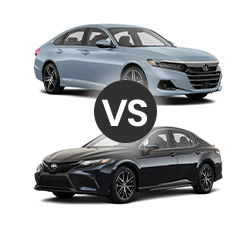2021 Honda Accord vs Toyota Camry
The 2021 Honda Accord and Toyota Camry have long been top of the class when it comes to reliable sedans. Its no surprise they've managed so well; with spacious cabins, capable engines, strong safety records - plus advanced technology features for 2021 - these cars offer the total package in comfort, quality and performance. With aspirations to make driving even more enjoyable than ever before, its clear that this dynamic duo is unbeatable!
Shopping for a sedan can be daunting, with so many models and trims available. But luckily, this overview provides an easy way to make the decision between two popular sedans - it'll explain how these cars differ from each other in order to help customers find one that fits their needs perfectly!
The Powertrain
Drivers of either a Honda Accord or Toyota Camry can choose from two distinct powertrains. The classic option for an Accord is equipped with a 1.5-liter, turbocharged four-cylinder engine that produces 192 horsepower and delightful torque at 192 pounds/feet - not bad! For those seeking something more, the hybrid Accords offer 2.0 liters matched up to an electric motor; as one unit they generate 212hp and 232 pound/feet of torque - making your ride even smoother than before!
The Accord offers an array of transmission options for a truly thrilling ride. The traditional powertrain trims feature either the continuously variable transmission with Sport mode or, on select versions, paddle shifters to make maneuvering more dynamic. But if you're looking for cutting-edge performance technology and superior quality, consider upgrading to the Touring version - it features both shift-by-wire controls and a ten-speed automatic gearbox! For perfect balance between efficiency and excitement even while reducing emissions levels choose one of the hybrid models – they offer electronic CVT transmissions plus Sport mode driving capabilities too.
Honda really focused on designing the Accord to be a car that people who love driving would enjoy. With this amount of power, the Accord offers some fun and excitement. Every trim is equipped with Hill Start Assist to prevent the car from rolling backwards after coign to a stop on slope. Select trims have a remote engine start function.
The Honda Accord is a phenomenal vehicle for those looking to conserve fuel. The Eco Assist feature and Idle-Stop program can help people accomplish this goal effectively, with hybrids earning up to an impressive 48 miles per gallon on both city roads or the highway! Non-hybrid Accords still perform well - depending on trim level drivers may get anywhere from 30 MPG (city) to 38 MPG (highway).
With Toyota's Camry, drivers have a variety of choices when it comes to powertrains. A reliable 2.5-liter four-cylinder engine is the standard offering and delivers an impressive 202 horsepower with 182 pound-feet of torque - giving you Honda Accord levels of performance! But if that doesn't quite meet your needs there are several alternative options available as well.
When Toyota decided to equip the Camry with all-wheel drive, it wasn't just news - it was groundbreaking. Suddenly, drivers in wintery climates had a sedan that could get them from point A to B safely and confidently on even the most treacherous roads. With this innovation, the Camry became unlike other cars of its class; an unstoppable powerhouse through snow or shine!
The new 2.5-liter engine with four cylinders is not only eco-friendly, but surprisingly powerful; it produces 208 horsepower when combined with its electric motor in the hybrid system! The Accord's impressive boost of power shows that you don't have to lose performance for sustainability - and makes this environmental choice a pragmatic one too.
The all-new Camry is ahead of the competition, offering drivers more power than ever before. Its V6 engine boasts a displacement of 3.5 liters and 301 horsepower with 267 pound-feet of torque - ensuring an enjoyable driving experience for those looking for some extra thrill behind the wheel! Currently only available in front-wheel drive options, Toyota's powerful new engine puts them at an advantage over competitors like Honda across both its XLE and XSE trims as well as its TRD trim option.
Toyota's new engines provide an unparalleled experience with their Direct Shift-8AT electronically controlled automatic transmissions. For a more hands-on approach, these 8 speeds have sequential shift mode to give drivers the same satisfaction as manual shifting. And for even better performance, hybrid systems are equipped with continuously variable transmissions offering seamless transitions and unbeatable efficiency backed by exciting torque from its cutting edge technology in sequential shifting.
The Toyota Camry offers drivers a range of options to customize their driving experience. With the Normal mode, one can enjoy an unaltered journey through town or country roads; alternatively, Sport mode turns up the excitement with more responsive performance while Eco wants you to relax back and follow along for less fuel consumption - getting you further down your route!
The Camry offers powerful fuel efficiency with hybrid options that max out at 53 miles per gallon on the highway and 51 in the city, while non-hybrid versions still reach impressive levels of 39 mpg on highways and 28 around town. The Accord is no slouch either offering comparable results to many of its hybrids' trims - nearly hitting match Toyota's mark but falling slightly short.
Like the Accord, the Camry has Hill Start Assist, and it has many trims that have remote start functions.
Drivability
With the XSE and TRD trims of the Camry, as well as Honda's Accord Touring trim packed in with performance-centric features such as an Adaptive Damper System, Active Cornering Assist and sport-tuned shock absorbers along with springs - these cars are built for pure driving pleasure. With plenty of power under their hoods to boot – they're sure to excite even avid car enthusiasts!
These sedans provide the perfect balance of size and space - not too big, not too small. With plenty of leg room for passengers plus enough trunk space to fit even the largest luggage loads, these cars offer maximum comfort without taking up excessive road real estate.
For those who need just a bit more room, the Honda Accord offers it; from 42.3 inches of legroom in the front to 16.7 cubic feet of trunk capacity - narrowly beating out its competition, Toyota's Camry with only 15.1 cubic feet inside and 40.4 inches in second-row legroom while still providing plenty of space for passengers up front at 42.1 inches.
It's a close race between the Honda Accord and Toyota Camry for parking tight spots! Almost identical in length, these two models barely separate themselves with just 0.1 inches of difference- so no need to worry about squeezing into those small spaces. And when it comes to ground clearance, they're neck and neck once more: both vehicles sit pretty low at 5.5 (Honda) and 5..7 (Toyota). It looks like this class is truly optimized for smooth city cruising - now let’s see who will come out on top as king of urban carparking!
Technology is going to be a major factor as customers select their next vehicles. After comparing the technology packages of the two cars, many would likely say that the Toyota Camry has the more attractive package. That's because each of its trims has an infotainment system that comes with six speakers, Android Auto and Apple CarPlay, Amazon Alexa, Bluetooth, SiriusXM, and Wi-Fi capability. Plus, each trim has at least three USB ports and a seven-inch touchscreen.
Different trim levels of the Honda Accord offer a range of technological features - from the minimal to extensive. The most basic models provide drivers with intelligent touchscreens, access to Apple CarPlay and Android Auto, Bluetooth capability, and even their own unique app (HondaLink). But for those wanting more tech-savvy options like SiriusXM radio or Amazon Alexa connectivity will have look elsewhere as these are not included in any level. Nevertheless some may find that this is 'enough technology' for them!
Higher trims of the Honda Accord can have up to three total USB ports, eight or ten speakers, SiriusXM and HD Radio, and wireless charging. The top trims have Wi-Fi capability and integrated navigation. Likewise, the Toyota Camry's premium models can have navigation, wireless charging, and nine-speaker JBL sound systems. They can be enhanced with nine-inch touchscreens.
To avoid overpaying on a new car, shop prices online first. Get up front pricing before you walk into a dealership. We recommend the following free services; Car Clearance Deals, NADAguides, CarsDirect & & Motortrend.
These free services will offer you the lowest prices and supply you with multiple competing price quotes. You will know the best price before you visit the dealer.
Safety
With technology like driver-assist, the latest Honda Accord and Toyota Camry are more than just your typical passenger vehicles - they've become lifesavers! Through its sophisticated sensors, these cars can detect potential issues on the road. In an instant response to danger, it'll alert drivers and give them a chance to take action before any harm is caused. So say goodbye to feeling powerless behind the wheel; with modern engineering like this in place you don't have worry as much about being involved in accidents anymore.
Honda Accords are the perfect car for safety-conscious drivers, offering Honda Sensing's suite of driver assistive technologies. Collision Mitigation Braking and Forward Collision Warning give you peace of mind when navigating busy roads in any weather - while Lane Keeping Assist, Road Departure Warning and Traffic Sign Recognition help keep your Accord on its best driving behavior at all times. Adaptive Cruise Control guarantees smooth sailing with automatic high beams to boot!
If you're in the market for a car, many of today's trims come with helpful extras like blind spot monitoring and rear cross-traffic alert. Upgrading to a Touring trim brings added safety features such as head-up display technology and low-speed braking control - making driving more convenient than ever!
Toyota upped their game with the Camry, equipping it not only with all of the same standard safety systems as other models but also introducing a new feature: pedestrian detection. This advanced capability allows drivers to detect both vehicles and people in its path for extra peace-of-mind when on the road!
For whatever reason, blind spot monitoring doesn't seem to be a standard component on many vehicles. Only select trims of the Toyota Camry have this feature. Like what is seen in the Accord, the Camry has a monitoring system that can account for vehicles in blind spots as well as vehicles that are crossing behind it while it's in reverse.
With the most premium trims of the Toyota Camry, drivers can access a high-tech head-up display. Complete with direction and speed limit notifications, this innovative feature is perfect for staying informed on long road trips! On top of that, an available bird's eye view camera provides an easy way to maneuver tight parking spots - giving you complete control as soon as you get behind the wheel.
Which Has the Best Value?
For decades, Honda and Toyota have been the greatest of rivals. Yet when it comes to delivering cars with optimal reliability and value for money, they are without comparison. The Accord from Honda and Camry from Toyota stand as icons in this regard - two vehicles that offer identical base trim pricing of $24,970 while being benchmark models amongst their peers.
The Camry and Accord are two of the most popular cars on the road, but it takes a bit more to make your choice if you're looking for top performance. With 12 trims ranging from basic utility up to high-end luxury, there's sure to be one that fits what you need - especially when compared with its 9 alternatives in Honda's Accord lineup! If budget is no concern then you might want to opt for Toyota's XSE V6 priced at $35,545 or splash out just slightly extra on Honda’s Hybrid Touring trim at an even higher cost of $36,440.
This overview has already discussed differences in performance, safety, and technology, so now, it will touch on the exterior and interior features. Since there are so many trims, it might be easier to just compare the Camry XSE V6 versus the Accord Hybrid Touring to quickly highlight what's available.
On the XSE V6, here are LED headlights and taillights, and there are heated side mirrors with turn signals and blind spot warning indicators, along with 19-inch wheels and a panoramic glass roof. There are leather seats, with the front ones being heated. Heating is available for the second row, and ventilation is available for the front row of seats. The Accord Hybrid Touring also has the same type of side mirrors, but its mirrors can tilt down when the car is in reverse. It has leather upholstery and a moonroof, though not a panoramic one, and it has 19-inch wheels, LED headlights, and LED fog lights. A bonus is that it has heated and ventilated front seats as well as heated rear seats as standard components.
Which is Better?
Choosing between two near-perfect cars can be a difficult decision. The Camry offers sporty styling, advanced technology and more powerful V6 engine options, whereas the Accord has refined sophistication with luxurious top trims and generous interior space. Ultimately it comes down to personal preference: do you prefer luxury or performance?

Get up to 4 local dealers to compete for your business by offering free, competitive pricing. Know before you go to the dealer.
Every dealer offers a secret price. Find yours here.
• 2021 Honda Accord VS Acura TLX
• 2021 Honda Accord VS Hyundai Sonata
• 2021 Honda Accord VS Mazda6
• 2021 Honda Accord VS Nissan Altima
• 2021 Honda Accord VS Toyota Camry


